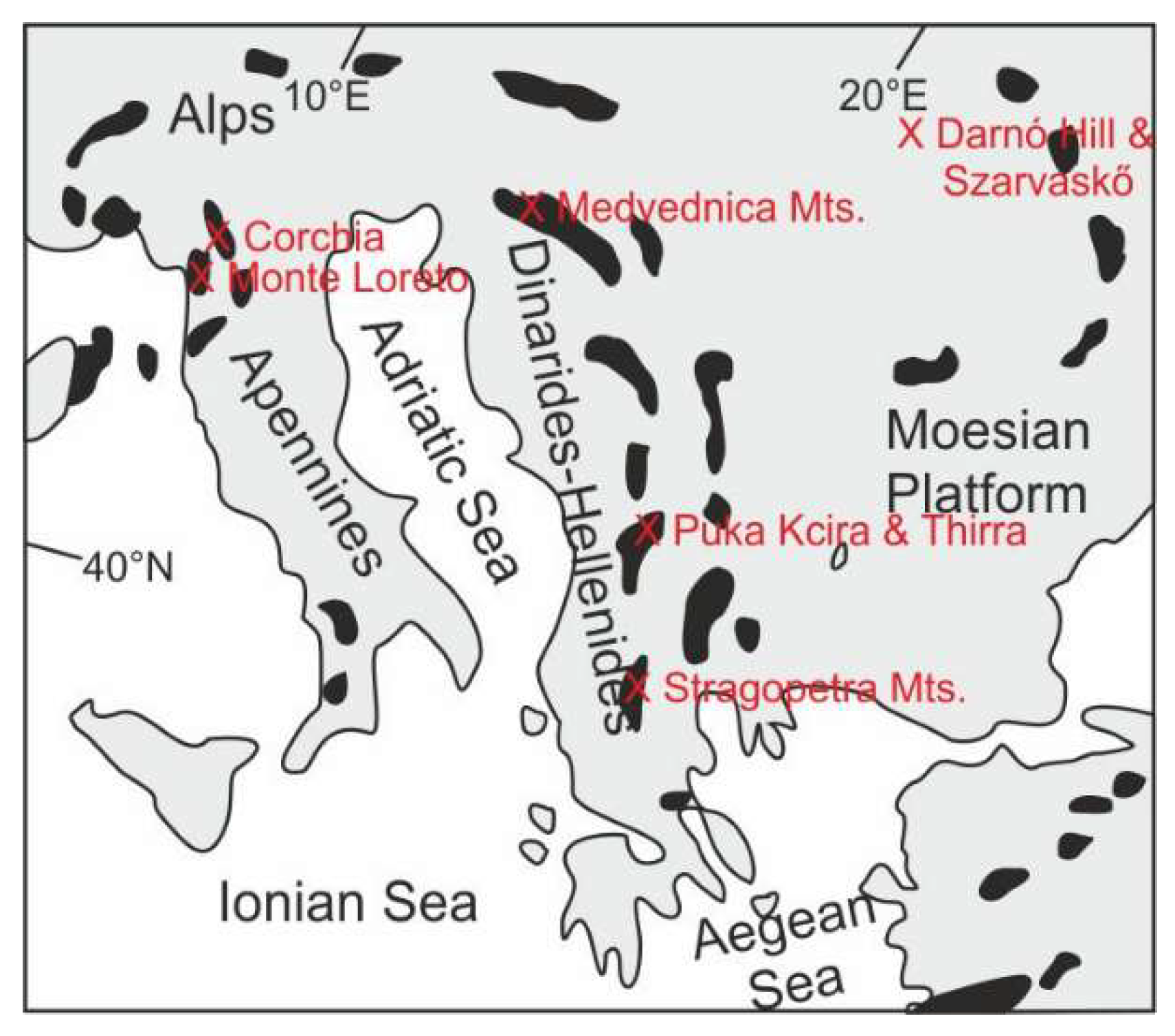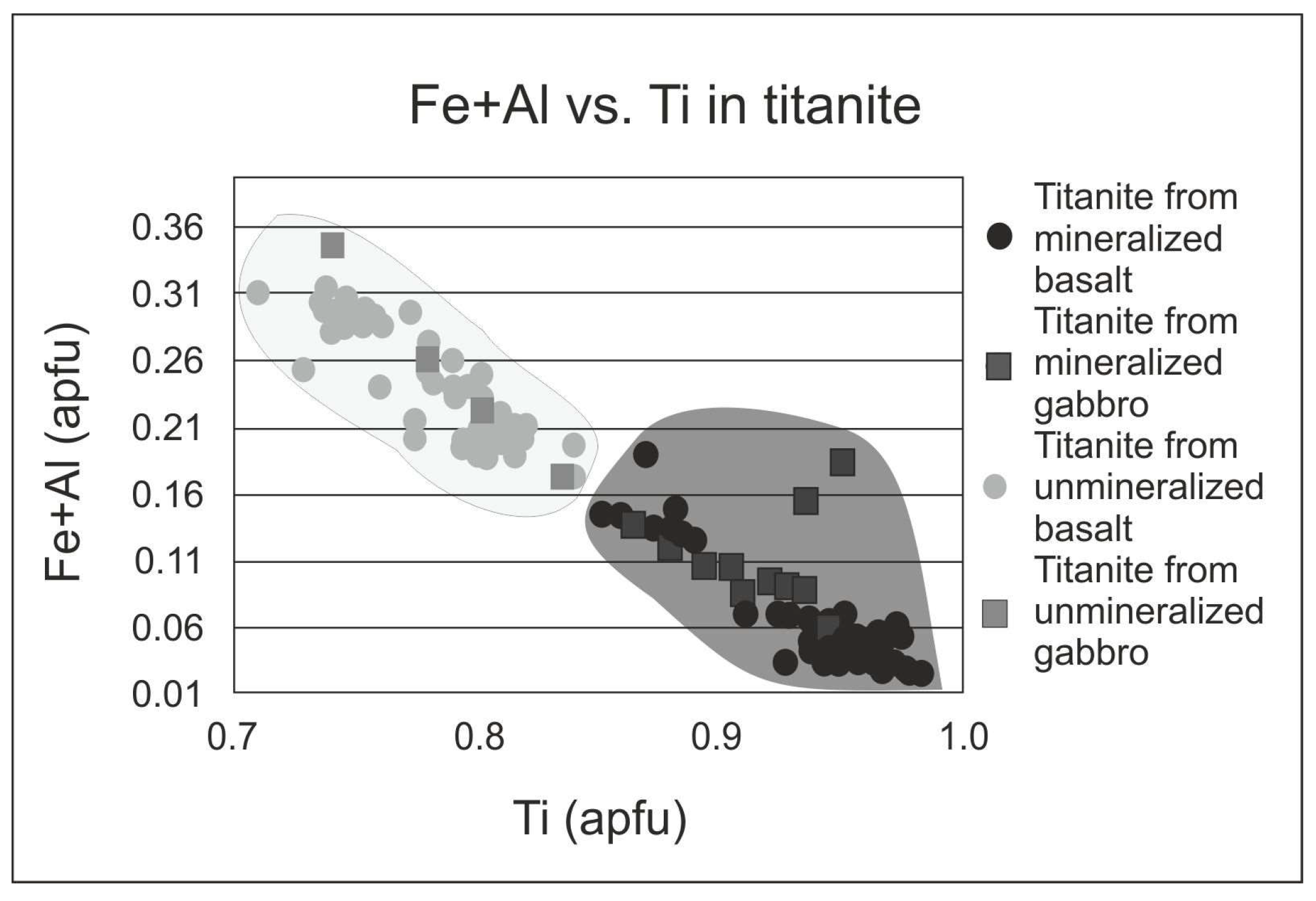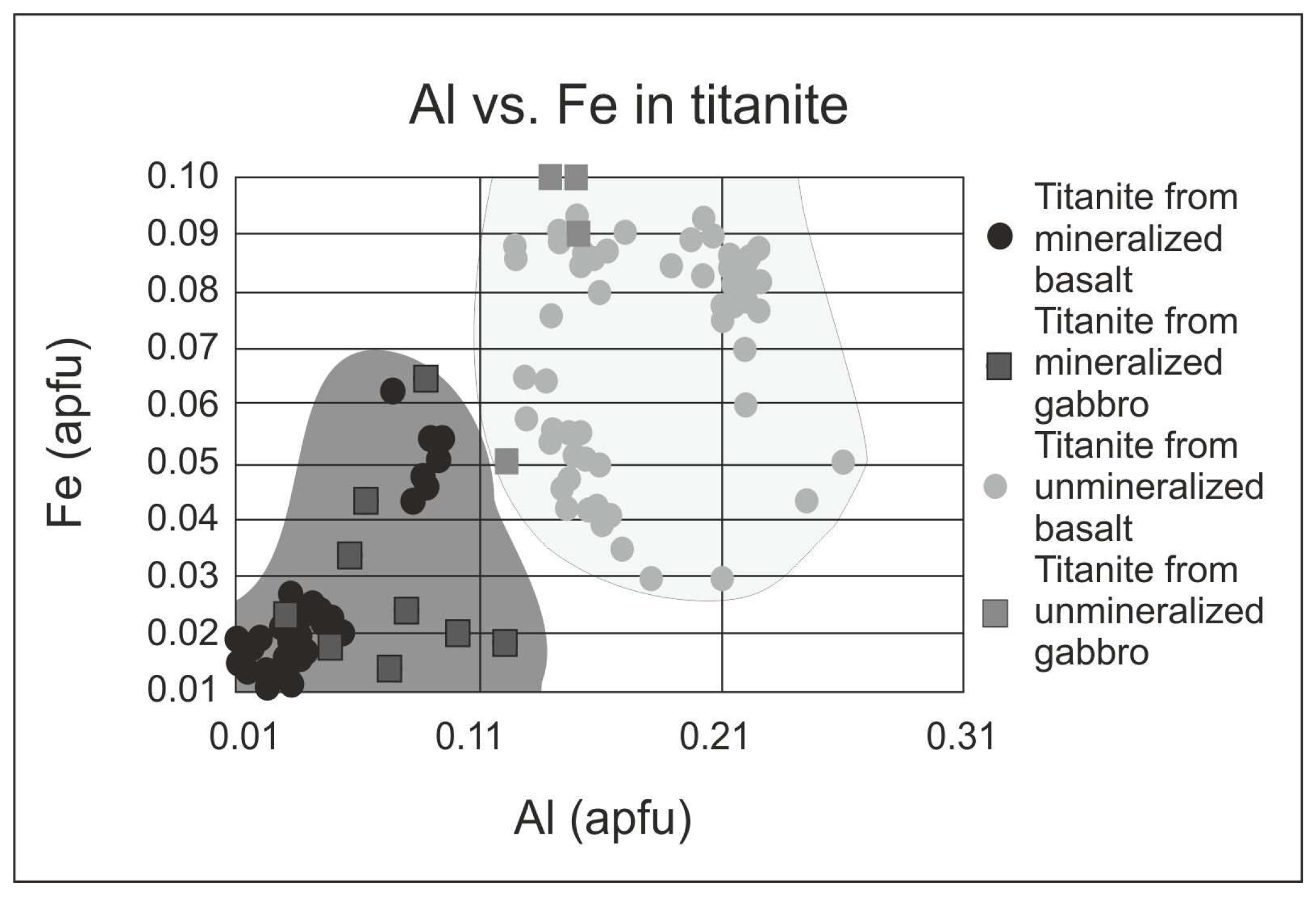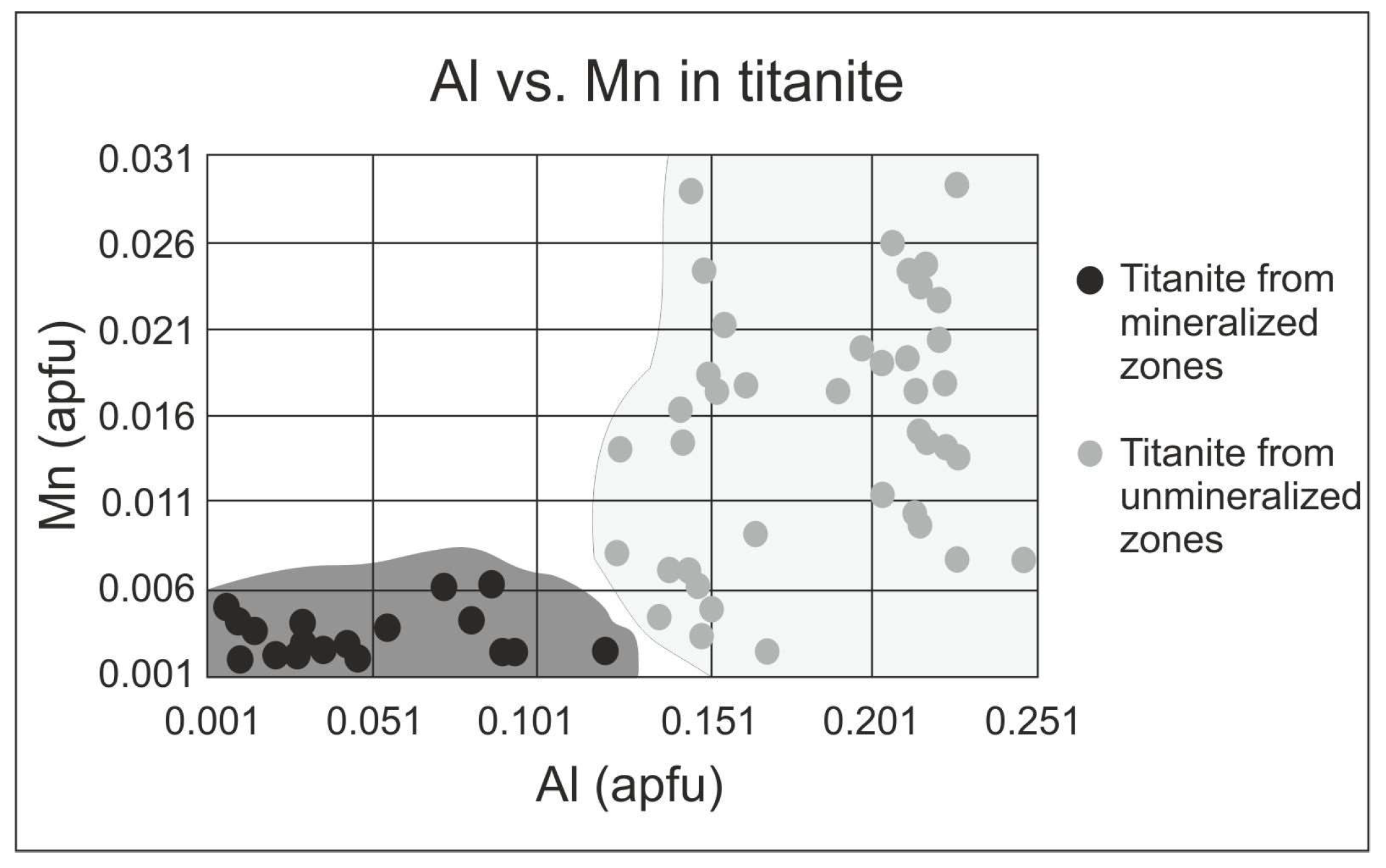Compositional Variations of Titanite: A Possible New Tool for Cyprus-Type Volcanogenic Massive Sulfide Deposit Prospecting
Abstract
1. Introduction
2. Background
2.1. Basic Mineralogy of Titanite and Its Element Substitutions
2.2. Geology of the Studied Samples
3. Materials and Methods
4. Results
5. Discussion
5.1. Element Substitution on the Ti Site
5.2. Charge Balancing
5.3. Element Substitutions on the Ca Site
5.4. Metal Substitutions
6. Concluding Remarks
- Titanite closer to stoichiometric composition (Ti (apfu) ≥ 0.85) is found in mineralized zones, while Ti (apfu) ≤ 0.85 characterizes titanite from unmineralized zones.
- A Fe+Al vs. Ti binary plot seems to be the most discriminant for distinguishing titanite from mineralized and unmineralized locations.
- On Al vs. Fe as well as Al vs. Mn diagrams, different fields can be assigned clearly for titanite compositions from mineralized and unmineralized zones.
- On a Si vs. Ca+Mn diagram—despite some overlapping—we may also be able to distinguish titanite grains of mineralized and unmineralized zone origins.
- The possibility of excess Fe substitution in Ca site occurs only in titanite from unmineralized zones.
- Higher Mn, F and occasionaly Zn, Cu contents are characteristic in titanite from unmineralized zones.
Author Contributions
Funding
Acknowledgments
Conflicts of Interest
Appendix A
| Si | Ti | Al | Fe+2 | Mn | Ca | Cu | Zn | Fe/Al | Fe + Al | Ca + Mn | F | |
|---|---|---|---|---|---|---|---|---|---|---|---|---|
| Si | 1 | |||||||||||
| Ti | −0.535 | 1 | ||||||||||
| Al | 0.156 | −0.898 | 1 | |||||||||
| Fe+2 | 0.323 | −0.788 | 0.697 | 1 | ||||||||
| Mn | 0.119 | −0.176 | 0.146 | 0.026 | 1 | |||||||
| Ca | −0.190 | −0.541 | 0.620 | 0.347 | 0.064 | 1 | ||||||
| Cu | 0.105 | −0.244 | 0.204 | 0.157 | 0.112 | 0.178 | 1 | |||||
| Zn | 0.042 | −0.053 | 0.078 | −0.040 | −0.202 | −0.045 | −0.121 | 1 | ||||
| Fe/Al | 0.138 | 0.284 | −0.466 | 0.060 | 0.072 | −0.429 | 0.021 | −0.199 | 1 | |||
| Fe + Al | 0.228 | −0.926 | 0.966 | 0.858 | 0.114 | 0.568 | 0.202 | 0.041 | −0.312 | 1 | ||
| Ca + Mn | −0.173 | −0.554 | 0.628 | 0.345 | 0.183 | 0.993 | 0.189 | −0.069 | −0.414 | 0.573 | 1 | |
| F | 0.592 | −0.702 | 0.653 | 0.534 | 0.208 | 0.570 | 0.437 | −0.075 | −0.248 | 0.620 | 0.565 | 1 |
Appendix B
| Si | Ti | Al | Fe+2 | Mn | Ca | Cu | Zn | Fe/Al | Fe + Al | Ca + Mn | F | |
|---|---|---|---|---|---|---|---|---|---|---|---|---|
| Si | 1 | |||||||||||
| Ti | −0.203 | 1 | ||||||||||
| Al | −0.122 | −0.806 | 1 | |||||||||
| Fe+2 | −0.087 | −0.472 | 0.097 | 1 | ||||||||
| Mn | −0.516 | −0.594 | 0.471 | 0.785 | 1 | |||||||
| Ca | −0.667 | 0.073 | −0.058 | 0.049 | 0.540 | 1 | ||||||
| Cu | −0.090 | 0.132 | −0.085 | −0.049 | −0.081 | −0.068 | 1 | |||||
| Zn | −0.212 | −0.031 | 0.127 | 0.008 | 0.013 | 0.082 | 0.023 | 1 | ||||
| Fe/Al | −0.032 | 0.024 | −0.456 | 0.817 | 0.401 | 0.108 | 0.039 | −0.082 | 1 | |||
| Fe + Al | −0.144 | −0.893 | 0.849 | 0.608 | 0.710 | −0.020 | −0.088 | 0.104 | 0.069 | 1 | ||
| Ca + Mn | −0.717 | −0.058 | 0.053 | 0.170 | 0.819 | 0.940 | −0.083 | 0.061 | 0.146 | 0.132 | 1 | |
| F | −0.724 | −0.811 | 0.882 | 0.658 | 0.726 | 0.749 | −0.009 | 0.062 | 0.009 | 0.972 | 0.841 | 1 |
References
- Gaines, R.V.; Skinner, H.C.W.; Foord, E.E.; Mason, B.; Rosenzweig, A.; King, V.T.; Dowty, E. The System of Mineralogy of James Dwight Dana and Edward Salisbury Dana, 8th ed.; John Wiley & Sons Inc.: New York, NY, USA, 1997; p. 1819. [Google Scholar]
- Harlov, D.; Tropper, P.; Seifert, W.; Nijland, T.; Förster, H.-J. Formation of Al-rich titanite (CaTiSiO4O–CaAlSiO4OH) reaction rims on ilmenite in metamorphic rocks as a function of fH2O and fO2. Lithos 2006, 88, 72–84. [Google Scholar] [CrossRef]
- Kowallis, B.J.; Christiansen, E.H.; Griffen, D.T. Compositional Variations in Titanite; Abstracts with Programs; Geological Society of America: Boulder, CO, USA, 1997; Volume 29, p. A-402. [Google Scholar]
- Kowallis, B.J.; Christiansen, E.H.; Dorais, M.J.; Winkel, A.; Henze, P.; Franzen, L.; Webb, H. Compositional variation of Fe, Al and F in Titanite (Sphene); Abstracts with Programs, Paper no. 137-11; Geological Society of America: Boulder, CO, USA, 2018; Volume 50. [Google Scholar]
- Hayden, L.A.; Watson, E.B.; Wark, D.A. A thermobarometer for sphene (titanite). Contrib. Mineral. Petrol. 2008, 155, 529–540. [Google Scholar] [CrossRef]
- Colwell, L.E.; John, B.E.; Cheadle, M.J.; Wooden, J.L. Chemistry of Titanite (Sphene) in Ocean Crust: A Tool for Understanding Late-Stage Igneous and Metasomatic Processes at Mid-Ocean Ridges; Fall Meeting 2011, abs. id. V11A-2493; American Geophysical Union: Washington, DC, USA, 2011. [Google Scholar]
- Bouzari, F.; Hart, C.J.R.; Bissig, T.; Lesage, G. Apatite and Titanite Characteristics of Porphyry Fertile Plutons. In Proceeding of the SEG2019 Conference Proceedings, Santiago, Chile, 7–10 October 2019; p. 041. [Google Scholar]
- Matthews, T.J.; Wilkinson, J.J.; Loader, M.A. Titanite Petrology and Chemistry from the Strontian Igneous Complex. In Proceeding of the SEG2019 Conference Proceedings, Santiago, Chile, 7–10 October 2019; p. 121. [Google Scholar]
- Xu, L.; Bi, X.; Hu, R.; Tang, Y.; Wang, X.; Xu, Y. LA-ICP-MS mineral chemistry of titanite and the geological implications for exploration of porphyry Cu deposits in the Jinshajiang—Red River alkaline igneous belt, SW China. Miner. Petrol. 2015, 109, 181–200. [Google Scholar] [CrossRef]
- Pan, L.C.; Hu, R.Z.; Bi, X.W.; Li, C.; Wang, X.S.; Zhu, J.J. Titanite major and trace element compositions as petrogenetic and metallogenic indicators of Mo ore deposits: Examples from four granite plutons in the southern Yidun arc, SW China. Am. Miner. 2018, 103, 1417–1434. [Google Scholar] [CrossRef]
- Shanks, W.C.P., III; Thurston, R. (Eds.) Volcanogenic massive sulfide occurrence model. In U.S. Geological Survey Scientific Investigations Report; 2010–5070–C; USGS: Reston, VA, USA, 2012; p. 345. [Google Scholar]
- Deer, W.A.; Howie, R.A.; Zussman, J. Rock-Forming Minerals: Orthosilicates, 2nd ed.; Geological Society of London: London, UK, 1982; Volume 1A, pp. 443–466. [Google Scholar]
- Oberti, R.; Smith, D.C.; Rossi, G.; Caucia, F. The crystal-chemistry of high-aluminium titanites. Eur. J. Miner. 1991, 3, 777–792. [Google Scholar] [CrossRef]
- Hannington, M.D.; Santaguida, F.; Kjarsgaard, I.M.; Cathles, L.M. Regional-scale hydrothermal alteration in the Central Blake River Group, western Abitibi subprovince, Canada: Implications for VMS prospectivity. Miner. Depos. 2003, 38, 393–422. [Google Scholar] [CrossRef]
- Pamić, J.; Tomljenović, B.; Balen, D. Geodynamic and petrogenetic evolution of alpine ophiolites from the central and NW Dinarides: An overview. Lithos 2002, 65, 113–142. [Google Scholar] [CrossRef]
- Piccardo, G.B.; Rampone, E.; Romairone, A. Formation and composition of the oceanic lithosphere of the Ligurian Tethys: Inferences from the Ligurian ophiolites. Ofioliti 2002, 27, 145–161. [Google Scholar]
- Robertson, A.H.F.; Karamata, S.; Šarić, K. Overview of ophiolites and related units in the Late Palaeozoic–Early Cenozoic magmatic and tectonic development of Tethys in the northern part of the Balkan region. Lithos 2009, 108, 1–36. [Google Scholar] [CrossRef]
- Kiss, G.; Molnár, F.; Palinkaš, L.A.; Kovács, S.; Hrvatović, H. Correlation of Triassic advanced rifting-related Neotethyan submarine basaltic volcanism of the Darnó Unit (NE-Hungary) with some Dinaridic and Hellenidic occurrences on the basis of volcanological, fluid–rock interaction, and geochemical characteristics. Int. J. Earth Sci. 2012, 101, 1503–1521. [Google Scholar] [CrossRef]
- Kiss, G.B.; Molnár, F.; Palinkaš, L.A. Hydrothermal processes related to some Triassic and Jurassic submarine basaltic complexes in northeastern Hungary, the Dinarides and Hellenides. Geol. Croat. 2016, 69, 39–64. [Google Scholar] [CrossRef]
- Zaccarini, F.; Garuti, G. Mineralogy and composition of VMS deposits of northern Apennine ophiolites, Italy: Evidence for the influence of country rock type on ore composition. Miner. Petrol 2008, 94, 61. [Google Scholar] [CrossRef]
- Garuti, G.; Bartoli, O.; Scacchetti, M.; Zaccarini, F. Geological setting and structural styles of Volcanic Massive Sulfide deposits in the northern Apennines (Italy): Evidence for seafloor and sub-seafloor hydrothermal activity in unconventional ophiolites of the Mesozoic Tethys. Bol. Soc. Geol. Mex. 2008, 60, 121–145. [Google Scholar] [CrossRef]
- Lovász, A.; Kiss, G.B.; Czuppon, G.; Benkó, Z. Genetic study of gabbro hosted copper mineralisations in the Albanian Mirdita Zone. In Geologica Balcanica, XXI International Congress of the CBGA; Neubauer, F., Brendel, U., Friedl, G., Eds.; Geologica Balcanica: Sofia, Bulgaria, 2018; p. 307. [Google Scholar]
- Doda, V.; Deda, V.; Alliu, I. Sulphide Mineralizations in Gabbro and Plagiogranites in Ophiolites of Albanides. Bul. Shke. Gjeol. 2014, 2, 374–377. [Google Scholar]
- Dilek, Y.; Furnes, H.; Shallo, M. Suprasubduction zone ophiolite formation along the periphery of Mesozoic Gondwana. Gondwana Res. 2007, 11, 453–475. [Google Scholar] [CrossRef]
- Higgins, J.B.; Ribbe, P.H. The crysta1 chemistry and space groups of natural and synthetic titanites. Am. Min. 1976, 61, 878–888. [Google Scholar]
- Seyfried, W.E., Jr.; Mottl, M.J. Hydrothermal alteration of basalt by seawater under seawater-dominated conditions. Geochim. Cosmochim. Acta 1982, 64, 985–1002. [Google Scholar] [CrossRef]







| Study Area | Location | Age | Rock Type | Volcanogenic Massive Sulfide Mineralization |
|---|---|---|---|---|
| Displaced fragments of the Dinarides (Hungary) | Darnó Hill, Nagy-Rézoldal Quarry | Triassic | Pillow basalt (WPB) | Barren |
| Darnó Hill, Mély Valley Quarry | Triassic | Pillow basalt (WPB) | Barren | |
| Szarvaskő, Kétvíz Hill SE | Jurassic | Pillow basalt, dolerite (BAB/IAB) | Barren | |
| Szarvaskő, Tardos Quarry | Jurassic | Gabbro (BAB/IAB) | Barren | |
| Dinarides-Hellenides (Croatia, Albania, Greece) | Medvednica Mts. S | Triassic | Pillow basalt (WPB) | Barren |
| Stragopetra Mts. W | Triassic | Pillow basalt (WPB) | Barren | |
| Stragopetra Mts S | Triassic | Pillow basalt (WPB) | Barren | |
| Stragopetra Mts. SW | Triassic | Pillow basalt (WPB) | Barren | |
| Thirra | Jurassic | Gabbro (SSZ) | Stockwork | |
| Puka-Kcira | Jurassic | Gabbro (MOR) | Stockwork | |
| Apennines (Italy) | Corchia | Jurassic | Pillow basalt (MOR) | Massive sulfide |
| Monte Loreto | Jurassic | Pillow basalt (MOR) | Stockwork |
| Titanite from Unmineralized Zones (n = 75) | Titanite from Mineralized Zones (n = 74) | ||||
|---|---|---|---|---|---|
| basalt | dolerite-gabbro | basalt | gabbro | ||
| Si | mean | 1.063 | 1.055 | 1.038 | 1.035 |
| min | 1.000 | 1.030 | 1.006 | 1.020 | |
| max | 1.130 | 1.100 | 1.063 | 1.068 | |
| st.dev. | 0.023 | 0.031 | 0.014 | 0.016 | |
| Ti | mean | 0.775 | 0.793 | 0.944 | 0.913 |
| min | 0.680 | 0.740 | 0.854 | 0.866 | |
| max | 0.840 | 0.840 | 0.983 | 0.943 | |
| st.dev. | 0.033 | 0.043 | 0.034 | 0.025 | |
| Al | mean | 0.179 | 0.138 | 0.038 | 0.072 |
| min | 0.124 | 0.110 | 0.006 | 0.047 | |
| max | 0.260 | 0.170 | 0.093 | 0.120 | |
| st.dev. | 0.037 | 0.028 | 0.023 | 0.023 | |
| Fe2+ | mean | 0.072 | 0.110 | 0.023 | 0.024 |
| min | 0.030 | 0.050 | 0.003 | 0.010 | |
| max | 0.130 | 0.180 | 0.063 | 0.043 | |
| st.dev. | 0.021 | 0.054 | 0.013 | 0.011 | |
| Mn | mean | 0.012 | n/a | 0.001 | 0.002 |
| min | b.d.l. | n/a | b.d.l. | b.d.l. | |
| max | 0.029 | n/a | 0.006 | 0.006 | |
| st.dev. | 0.009 | n/a | 0.002 | 0.002 | |
| Ca | mean | 0.969 | 0.983 | 0.956 | 0.968 |
| min | 0.880 | 0.890 | 0.923 | 0.934 | |
| max | 1.030 | 1.020 | 0.980 | 0.979 | |
| st.dev. | 0.020 | 0.062 | 0.013 | 0.014 | |
| Cu | mean | 0.002 | n/a | 0.001 | 0.002 |
| min | b.d.l. | n/a | b.d.l. | b.d.l. | |
| max | 0.009 | n/a | 0.006 | 0.004 | |
| st.dev. | 0.003 | n/a | 0.002 | 0.002 | |
| Zn | mean | 0.001 | n/a | 0.001 | 0.001 |
| min | b.d.l. | n/a | b.d.l. | b.d.l. | |
| max | 0.006 | n/a | 0.005 | 0.005 | |
| st.dev. | 0.002 | n/a | 0.001 | 0.002 | |
| Fe/Al | mean | 0.413 | 0.786 | 0.663 | 0.380 |
| min | 0.143 | 0.417 | 0.321 | 0.118 | |
| max | 0.740 | 1.059 | 1.861 | 0.693 | |
| st.dev. | 0.046 | 0.076 | 0.036 | 0.021 | |
| Fe + Al | mean | 0.251 | 0.248 | 0.060 | 0.096 |
| min | 0.187 | 0.170 | 0.010 | 0.064 | |
| max | 0.380 | 0.350 | 0.147 | 0.139 | |
| st.dev. | 0.046 | 0.076 | 0.036 | 0.021 | |
| Ca + Mn | mean | 0.980 | n/a | 0.957 | 0.970 |
| min | 0.880 | n/a | 0.923 | 0.934 | |
| max | 1.030 | n/a | 0.982 | 0.985 | |
| st.dev. | 0.335 | n/a | 0.013 | 0.011 | |
| F | mean | 1.318 | n/a | 0.101 | n/a |
| min | b.d.l. | n/a | b.d.l. | b.d.l. | |
| max | 2.175 | n/a | 0.223 | b.d.l. | |
| st.dev. | 0.652 | n/a | 0.053 | n/a | |
© 2020 by the authors. Licensee MDPI, Basel, Switzerland. This article is an open access article distributed under the terms and conditions of the Creative Commons Attribution (CC BY) license (http://creativecommons.org/licenses/by/4.0/).
Share and Cite
B. Kiss, G.; Zaccarini, F. Compositional Variations of Titanite: A Possible New Tool for Cyprus-Type Volcanogenic Massive Sulfide Deposit Prospecting. Geosciences 2020, 10, 290. https://doi.org/10.3390/geosciences10080290
B. Kiss G, Zaccarini F. Compositional Variations of Titanite: A Possible New Tool for Cyprus-Type Volcanogenic Massive Sulfide Deposit Prospecting. Geosciences. 2020; 10(8):290. https://doi.org/10.3390/geosciences10080290
Chicago/Turabian StyleB. Kiss, Gabriella, and Federica Zaccarini. 2020. "Compositional Variations of Titanite: A Possible New Tool for Cyprus-Type Volcanogenic Massive Sulfide Deposit Prospecting" Geosciences 10, no. 8: 290. https://doi.org/10.3390/geosciences10080290
APA StyleB. Kiss, G., & Zaccarini, F. (2020). Compositional Variations of Titanite: A Possible New Tool for Cyprus-Type Volcanogenic Massive Sulfide Deposit Prospecting. Geosciences, 10(8), 290. https://doi.org/10.3390/geosciences10080290





